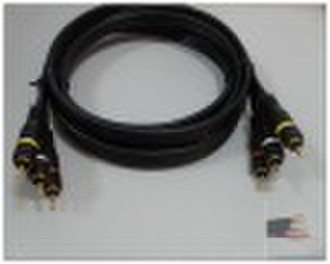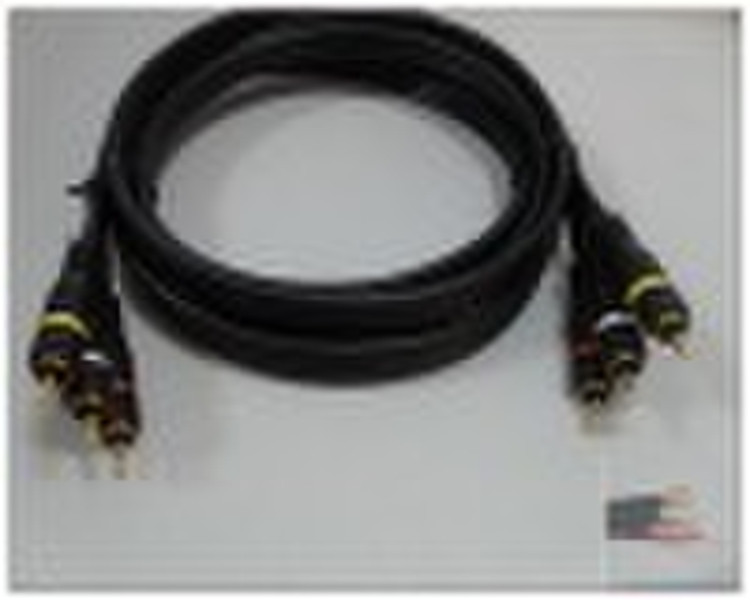Catalog
-
Catalog
- Agriculture
- Apparel
- Automobiles & Motorcycles
- Beauty & Personal Care
- Business Services
- Chemicals
- Construction & Real Estate
- Consumer Electronics
- Electrical Equipment & Supplies
- Electronic Components & Supplies
- Energy
- Environment
- Excess Inventory
- Fashion Accessories
- Food & Beverage
- Furniture
- Gifts & Crafts
- Hardware
- Health & Medical
- Home & Garden
- Home Appliances
- Lights & Lighting
- Luggage, Bags & Cases
- Machinery, Hardware & Tools
- Measurement & Analysis Instruments
- Mechanical Parts & Fabrication Services
- Minerals & Metallurgy
- Office & School Supplies
- Packaging & Printing
- Rubber & Plastics
- Security & Protection
- Service Equipment
- Shoes & Accessories
- Sports & Entertainment
- Telecommunications
- Textiles & Leather Products
- Timepieces, Jewelry, Eyewear
- Tools
- Toys & Hobbies
- Transportation
Filters
Search

RCA CABLE 3 RCA CABLE RCA VIDEO CABLE RCA AUDIO CA
original price: 1,00 USD
China

HAO WANG
Contact person
Basic Information
| Place of Origin | Guangdong China (Mainland) |
|---|---|
| Brand Name | HK |
| Model Number | RCA CABLE |
1.RCA CABLE 2.RCA AUDIO CABLE 3.RCA VIDEO CABLE 4.RCA 3 TO RCA 3 CABLE 5.DC 3.5 TO RCA CABLE VGA TO RCA CABLE --------------------------------------------------------------- Specifications: 1)3RCA composite Video+Audio cable. 2)Get composite RCA video and qudio connectors all in one cable. 3)Gold-plated composite RCA Video and Audio cable is specifically designed to providesharp and clear video and sound for your home theatre system. 4)All cable of copper wire. 5)You can connect video equipment with composite and audio output jacks to televisions and projestors with composite video and audio input jacks. 6)The 24K Gold-Plated heavy duty RCA male connectors on each end provide excellent strain rellef to keep your cable intact. 7)An ultra flexible PVC jacket and color coded connectors help to simplify installation. 8)Heavy duty PVC jacket provides maximum protection to the cable while minimizing signal loses and statics. 9)Unparalleted quality and Top-Line performance for home theater ayudio equipment. 10)AV cable Type:Audio/Video cable 11)Connectivity:3RCA TO 3RCA cable,RCA TO RCA cable,DC TO 2RCA cable,DC TO 3RCA cable all are in our production line. AV cables also produce the following products:RCA TO SCART cable,RCA audio cable,RCA video cable,RCA cable to video cable,RCA component cable,RCA audio video cable,BNC cable,Composite RCA cable,Coaxial RCA cable.RCA Corporation, founded as Radio Corporation of America, was an electronics company in existence from 1919 to 1986. Currently, the RCA trademark is owned by the French conglomerate Thomson SA through RCA Trademark Management S.A., a company owned by Thomson. The trademark is used by Sony Music Entertainment and Thomson SA, which licenses the name to other companies like Audiovox and TCL Corporation for products descended from that common ancestor. Organization by General Electric On August 4, 1914, the United Kingdom and France declared war on Germany and Austria-Hungary, starting World War I. Radio traffic across the Atlantic Ocean increased dramatically after the Germans cut Allied cable telegraphs. During the war, the United States Navy suppressed patents owned by the major companies involved with radio manufacture in the United States to facilitate the war effort. All production of radio equipment was allocated for the Army and Navy. The Navy sought to maintain a government monopoly of wireless radio; however, the wartime command system over radio was to eventually end by the tabling of the maintenance of government control by the U.S. Congress in 1918. The rejection of the government monopoly did not prevent the Navy from creating a national radio system. On April 8, 1919, U.S. Navy Captain Stanford C. Hooper and Admiral W. H. G. Bullard met with General Electric Company executives to ask that they not sell their Alexanderson alternators to the British-owned Marconi Company and its subsidiary Marconi Wireless Telegraph Company of America. The premise of the Navy's proposal was that if GE created an American owned radio company, then the Navy would secure a commercial monopoly of long-distance radio communication. This marked the beginning of negotiations by which GE would buy American Marconi and organize what would become the Radio Corporation of America. RCA was one of the eight major computer companies (along with IBM, Burroughs, Control Data Corporation, General Electric, Honeywell, NCR and UNIVAC) through most of the 1960s. RCA marketed the Spectra 70 Series (70/15, 70/25, 70/35, 70/45, 70/46, 70/55, 70/60, 70/61) that were compatible with IBMs 360 series and the RCA Series (RCA 2, 3, 6, 7) competing against the IBM 370. These systems all ran RCAs real memory operating systems, DOS and TDOS. RCAs Virtual Memory Systems, the Spectra 70/46 and 70/61 and the RCA 3 and 7 could also run their Virtual Memory Operating System, VMOS. VMOS was originally named TSOS (Time Sharing Operating System), but was renamed in order to expand the system beyond the time sharing market. In fact RCA was credited with coining the term Virtual Memory. TSOS was the first mainframe, demand paging, virtual memory operating system on the market. The English Electric System 4 range, the 4-10, 4 -30, 4-50,4-70 and the time-sharing 4-75 computers were essentially RCA Spectra 70 clones of the IBM System /360 and 370 range. RCA abandoned computers in 1971. In January 1972, Sperry officially took over the RCA base. RCA Graphic Services Division (GSD) was a pioneer in computerized typesetting, marketing the Rudolph Hell Digiset as the VideoComp 800 with a Spectra computer running the FileComp composition system. The system would also typeset from tapes composed on a mainframe using the RCA Page-1 composition system. When RCA left the computer field, support of the VideoComp was taken over by Information International Inc. (known in the typesetting industry as Triple-I). RCA was a major proponent of the eight-track tape cartridge, which it launched in 1965. The eight-track cartridge initially had a huge and profitable impact on the consumer marketplace. However, sales of the 8-track tape format peaked early on as consumers increasingly favored the compact cassette tape format developed by competitor Philips.
Delivery terms and packaging
Packaging Detail: TRANSPARENT POLY BAGSBOX 46X30X30CM Delivery Detail: 7 days
Port: HONGKONG/SHENZHEN
Payment term
Telegraphic transfer
MoneyGram
Paypal
Western Union
-
Payment Methods
We accept:








